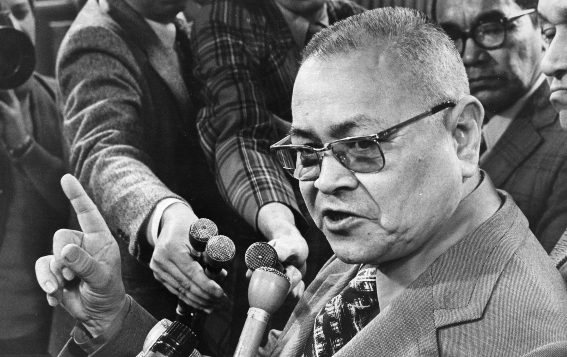The Calder Case 1973: A Landmark in Canadian Legal History

In the world of Canadian jurisprudence, one case stands out as a pivotal moment in the recognition of Indigenous land rights: the Calder Case of 1973. In this article, we delve into the legacy of Frank Calder and the profound impact of the Calder Case on land claims issues in Canada. This landmark legal battle, known officially as Calder v. British Columbia, also known as Calder vs. Attorney General of British Columbia, has left an indelible mark on the nation’s history.
Background and Historical Context
To truly appreciate the significance of the Calder Case, it is essential to understand the historical context in which it unfolded. The mid-20th century was a time of great change and social upheaval in Canada. Indigenous communities, including the Nisga’a Nation, to which Frank Calder belonged, were grappling with the loss of their traditional lands due to colonization and government policies.

Frank Calder: A Trailblazing Advocate
Frank Calder was not just an ordinary member of the Nisga’a Nation; he was a visionary leader and a dedicated advocate for Indigenous rights. Born in 1915 in Nass Harbour, British Columbia, Calder witnessed firsthand the encroachment of non-Indigenous settlers on his ancestral lands. This injustice fueled his determination to seek justice through the legal system.
In 1967, Frank Calder, along with other Nisga’a leaders, decided to take their land claims dispute to the courts. Their goal was to secure recognition of their Aboriginal title and, by extension, the rights to their traditional territories. Little did they know that their case would become a turning point in Canadian history.
The Calder Case Unfolds
The legal battle in Calder v. British Columbia was arduous and marked by numerous appeals. The Nisga’a Nation’s legal team, led by Calder himself, argued that their Aboriginal title to their traditional lands had never been extinguished by government actions. The province of British Columbia, on the other hand, contended that Indigenous land rights had been lawfully extinguished through a series of historical agreements.
The case went through several levels of the Canadian judicial system, eventually reaching the Supreme Court of Canada. The highest court in the land would be the ultimate arbiter of this historic dispute.
The Landmark Decision
On November 8, 1973, the Supreme Court of Canada delivered its verdict in the Calder Case. In a landmark decision, the Court ruled in favor of Frank Calder and the Nisga’a Nation. The judgment affirmed the existence of Aboriginal title in Canadian law and recognized that Indigenous peoples had a legal right to their traditional lands.
The implications of this decision were profound. It not only recognized the rights of the Nisga’a Nation but also set a precedent for other Indigenous communities across Canada. The Calder Case laid the groundwork for future land claims negotiations and reshaped the legal landscape in Canada.
The Legacy of the Calder Case
The Calder Case opened the door for Indigenous communities to assert their land rights through the legal system. Subsequent legal battles, such as the Calder-inspired Calder and Calder case and the landmark Calder Trilogy, further solidified the recognition of Aboriginal title in Canada.
Land Claims Agreements
In the years following the Calder Case, negotiations between Indigenous groups and the Canadian government led to the signing of numerous land claims agreements. These agreements aimed to rectify historical injustices and provide Indigenous communities with a path toward self-determination and economic prosperity.
The Nisga’a Treaty
One of the most significant outcomes of the Calder Case was the negotiation and signing of the Nisga’a Treaty. In 1998, the Nisga’a Nation became the first Indigenous group in Canada to finalize a modern treaty with the federal and provincial governments. This historic agreement provided the Nisga’a people with self-governance rights, control over their lands, and a share of resource revenues.
Reflections from Northern Public Affairs
To gain further insights into the legacy of Frank Calder and the impact of the Calder Case on land claims issues in Canada, you can refer to the article by Edward Allen, published in September 2013 in “Northern Public Affairs.” Allen’s article, titled “Letter from British Columbia: Reflections on the 40th Anniversary of the Calder Decision,” provides a comprehensive examination of this historic event and its enduring significance.
Northern Public Affairs, in its commitment to shedding light on critical issues in Northern Canada, has archived this valuable piece of scholarship on page 7 of their publication. You can access the original article to delve deeper into the Calder Case’s historical context, legal implications, and its profound influence on Indigenous land rights.
The Calder Case of 1973, with its landmark Supreme Court decision, forever altered the legal landscape in Canada. It recognized the rights of Indigenous peoples to their traditional lands and set the stage for future land claims agreements and self-determination. Frank Calder’s dedication and the perseverance of the Nisga’a Nation in pursuing justice serve as an enduring legacy of this historic case. In the ongoing journey towards reconciliation and justice for Indigenous peoples in Canada, the Calder Case stands as a beacon of hope and a testament to the power of the legal system to right historical wrongs.



